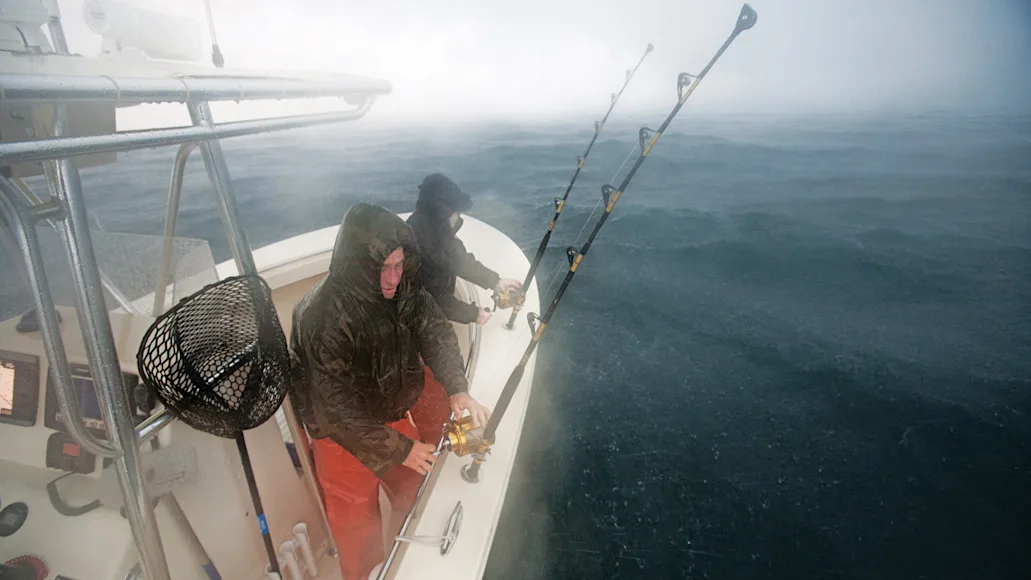MICK CHIVERS lowered the rod as the gaff struck the bluefish and his brother Jack swung the fish over the gunwale. It was a nice fish—about a 6-pounder—good both for the table and for light-tackle game. Using spinning tackle, Mick, who is 9, had hooked the fish on a popper in about 15 feet of water. The fish had run, circled the boat, and leapt twice. Now it was headed for ice. Except that in Mick’s mind, there remained a step.
“Bleed it,” he said.
On this day I served as both skipper and mate for sons who soon will do these things for me. I took the knife from the bait table and made a series of quick cuts. As the blood began to rush, I put the fish nose down into a bucket.
We had been thick into a school of feeding blues for almost an hour. Mick and Jack, 11, had boated nearly 10 fish, keeping me busy in the best kind of way. The cooler was heavy with meat. The blood in the bucket was already 2 or 3 inches deep.
Why would three guys in a boat busy with fish add a step like this?
The answer could begin in many places. But it certainly does not begin here, on this early August evening off Point Judith, R.I., as we harvested blues. It’s better told from an October three years before, and a journey to catch a shark.
Guest of Honor
Capt. Bill Brown, skipper of the Billfish and one of the country’s better-known shark-chasing charter captains (billfishcharter.com
), surveyed the Atlantic horizon from under the T‑top of my boat. Brown trained decades ago as a Navy pilot, and though he was 61 years old on this cool fall morning offshore, he retained a visual acuity no one in the day’s four-man crew could match. We were roughly 65 miles out, rising and falling on a light swell, near the edge of the temperature break near Jenny’s Horn, a jagged edge on the 30-fathom contour line. The green-sea-meets-blue-gray-sky horizon seemed blank to the rest of us. But not to the guest captain.
“There,” he said. “Boat.”
We squinted toward where his blue eyes were locked. Nothing.
“Head over there,” he said.
I pushed the dual throttles forward. The boat rose onto plane and began to rush forward, heading, it seemed, farther into the nothingness. After a mile the outline of a white sportfishing boat began to take shape. Then more. The boats were clustered around a pair of trawlers hauling back their nets. Several minutes later, I eased back on the throttles. Our 26-foot center console settled softly into the swell, well short of the bobbing pack. The day’s sharking tutorial was about to begin.
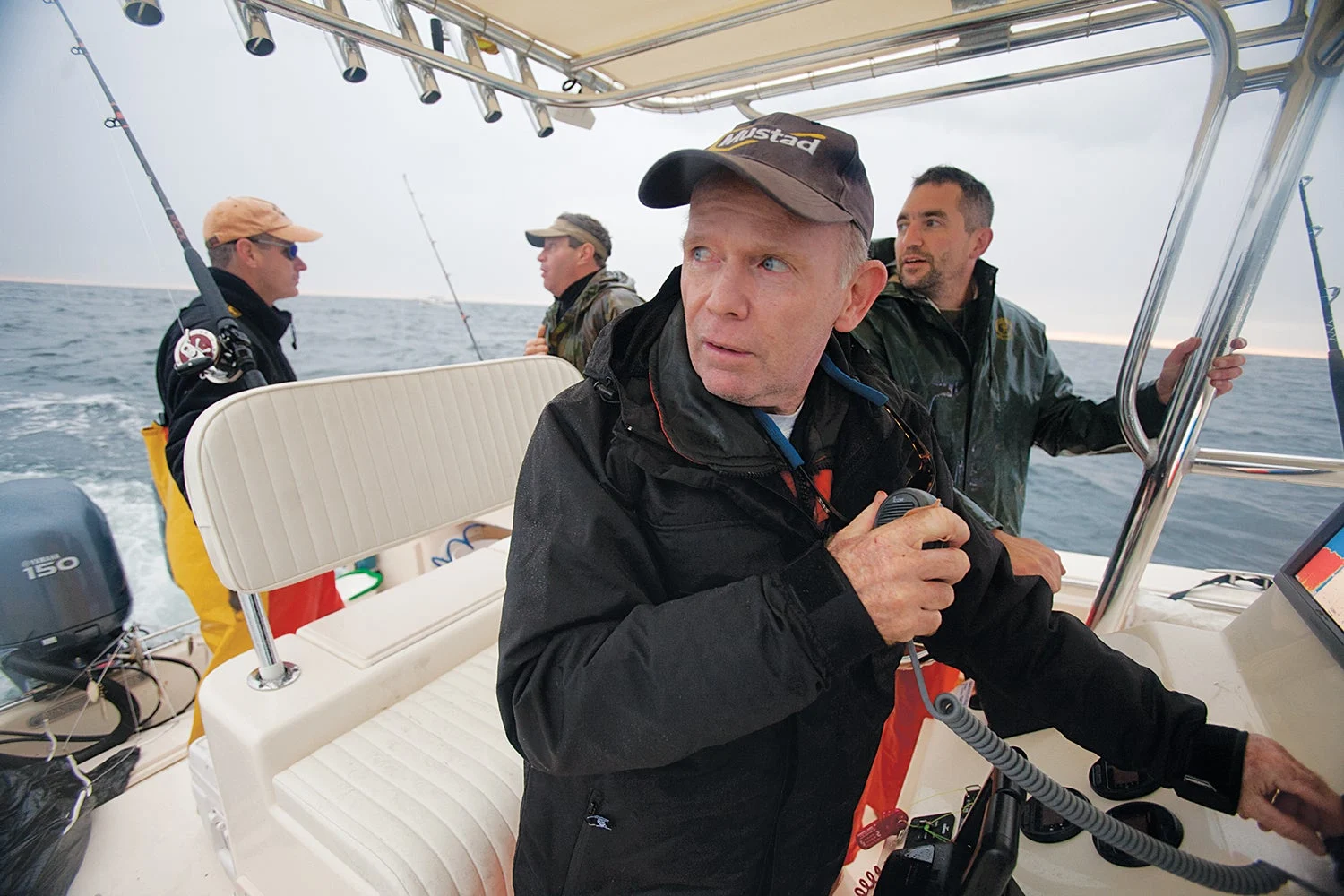
Capt. Brown (with radio) and the author eye the storm. Tyler Hicks
How Brown ended up on this boat is something of a story in itself. Brown is a generous soul, and as a former Navy officer he had made something of a personal goal in training one Air Force veteran of the Iraq wars to be a shark fisherman. That fisherman was Mike Perra, whom I met on assignment for this magazine (“A Sportsman at War
,” March 2008). Perra in turn introduced me to Brown, who learned I was in the process of buying and outfitting a saltwater fishing boat to use as a personal sanctuary, meat-gathering machine, and family classroom. The boat was to be a workhorse that could do many things—a heavy hull with a deep-V that could make the run offshore but also fish in tight, giving my sons a chance to learn everything from drifting for fluke and chasing 11-inch scup on inshore rock piles to setting up in the canyons and trying for tuna, marlin, mahimahi, swordfish, and shark. Its limits would be set by our skills and desires, not by the boat.
Perra had brought along one of a shark fisherman’s mojo baits—a jug of bluefish blood he had gathered himself, shot by shot, by bleeding blues.
In early 2008, as the boat was being built, Brown gave me a call with suggestions for customizing the vessel to be more effective—and safer. Brown listened to my thinking, rooted in what I had learned in the infantry: build in redundancy. The boat would be outfitted with extra batteries, dual engines, dual two-way radios, and GPS antennas and screens. Life jackets would be fitted with lights triggered by water-activated switches. A buoyant ditch bag—to go over the gunwale with the crew were the boat ever lost—would carry a floating handheld radio, a first-aid kit, and an EPIRB locator beacon. And the boat would have radar—essential for fishing seas prone to swift weather changes and enveloping fogs; the more so for avoiding collisions with shipping traffic and while passing through the narrow entrances in the seawalls at Harbor of Refuge, where the boat would be slipped.
To this planning, Brown added a guiding thought: “Going to sea,” he said, “can be like going to space.” What he meant was that when something goes wrong, the elements turn harsh and unforgiving fast, and you should expect there to be nothing to help you except what you brought. Fresh water, tools, lines, food, bandages—anything you might need could come only from your foresight. The sea as the cosmos? An exaggeration, for sure. But it was worth thinking of when running a boat at night on the open water, as I intended to do, because that is when striped bass feed best.
As we talked, Brown offered to guide a crew and me on an instructional offshore trip. He would come aboard as guest skipper, and watch over my shoulder, offering advice while we worked. He knew I had fished inshore, and had found my way around many of the rocks where striped bass stack. He also knew that venturing out—to the East Grounds, to Coxes Ledge, to the Acid Barge and beyond, toward the undersea canyons at the submerged continent’s edge—was another matter. He promised to demonstrate tricks for bringing large oceanic fish to the rail, and coach habits that make such trips possible in a small boat. Soon we were looking for crew.
The first pick was automatic: Mike Perra, the explosive ordnance disposal supervisor who lived nearby. Next was Tommy Frye, a carpenter friend who is also an obsessed fisherman and part-time mate out of Block Island. A former kickboxer, strong and fit in his 50s, he had picked up a nickname from his carpenter friends that suggested he would be ideal for wrestling big fish: “Silverback.” Rounding out the crew would be Tyler Hicks, the New York Times combat photographer who is my regular reporting partner, and who had taken up saltwater fishing with a passion.
Before the trip, Brown had given me an assignment: catch bluefish and have them iced on the boat. The day before, Jack, Mick, and I headed out to Block Island’s North Rip and trolled back and forth along the bar. But our luck was such that striped bass were thick that day. They kept jumping on before any blues struck. This created an unusual fishing scene: of a father and two sons grousing at excellent striper fishing, asking the seas for a run of blues. No bluefish came aboard that day. The next day at dawn we left the dock with only a few bluefish fillets Perra had brought from Massachusetts. To this we added buckets of bunker chum, flats of frozen butterfish, boxes of squid, and jugs of bunker oil. Perra had also brought along one of a shark fisherman’s mojo baits—a jug of bluefish blood he’d gathered himself, shot by shot, by bleeding blues as he hauled them in over the previous weeks. Brown was not quite content, and we stopped a short distance off the coast and briefly trolled a wire-line rig and picked up a midsize blue for fresh bait. Then we powered up and headed out.
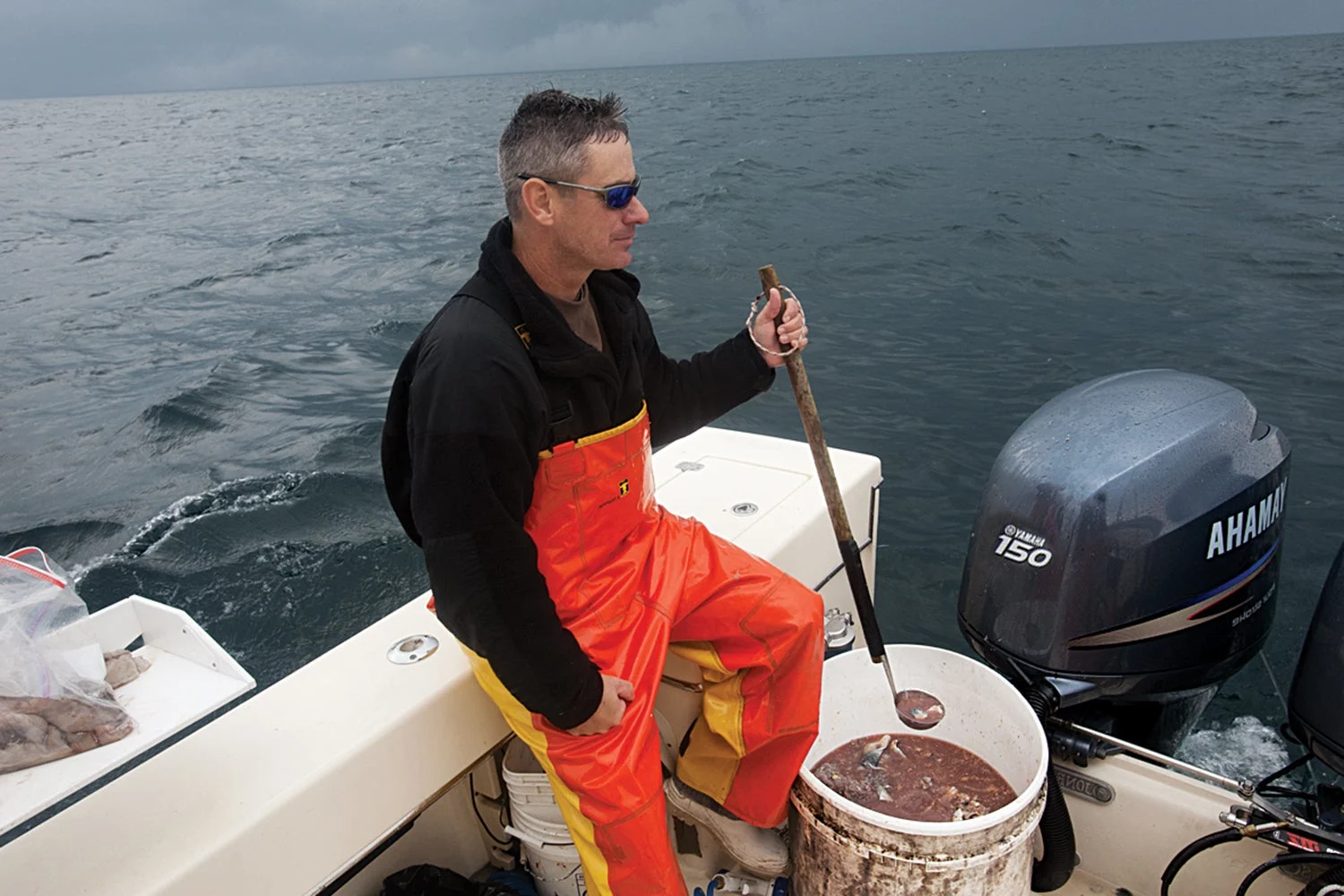
Mike Perra ladles chum over the transom. Tyler Hicks
Brown had sat around a table with us the night before and logged on to a satellite service that showed ocean surface temperatures offshore. He marked a spot of warmer water—almost 70 degrees. We arrived near the break after a three-hour open-ocean run.
The presence of trawlers merited a stop. As the big vessels’ crews hauled back the nets and the fishermen aboard sorted the contents, they tossed back the by-catch—the nonmarketable species. This created two long slicks of food trailing downtide from their sterns. Many species of offshore fish are opportunists. Like seagulls, rats, or bears, they are attuned to the habits of man. The open-ocean water column can be barren, and the sound of draggers sorting catch—the whine and grind of the winches retrieving the nets, and diesel thrum of idling engines—can be a meal bell for sharks and tuna, which will rush the boat from afar to feed from the discards as they are shoveled over the side. Would these draggers toll in sharks? Brown watched as other boats edged in tight, dunking heavy baits into the slick with thick rods and reels the size of mason jars. He looked into the water, which was clear and a shade bluer than the inshore green. He reached into the bait box, tossed over a dead squid, and watched it drift away quickly. The tide was moving fast.
He had a better idea. In a crowd, he knew, a boat needs to create its advantage. He told me to drive off about three-fourths of a mile and stop. Then he lifted a heavy bucket, riddled with drilled holes. Inside was a log of frozen bunker chum. He lowered the bucket into the water, lashed it to a stern cleat, and told me to drive back slowly toward the slick.
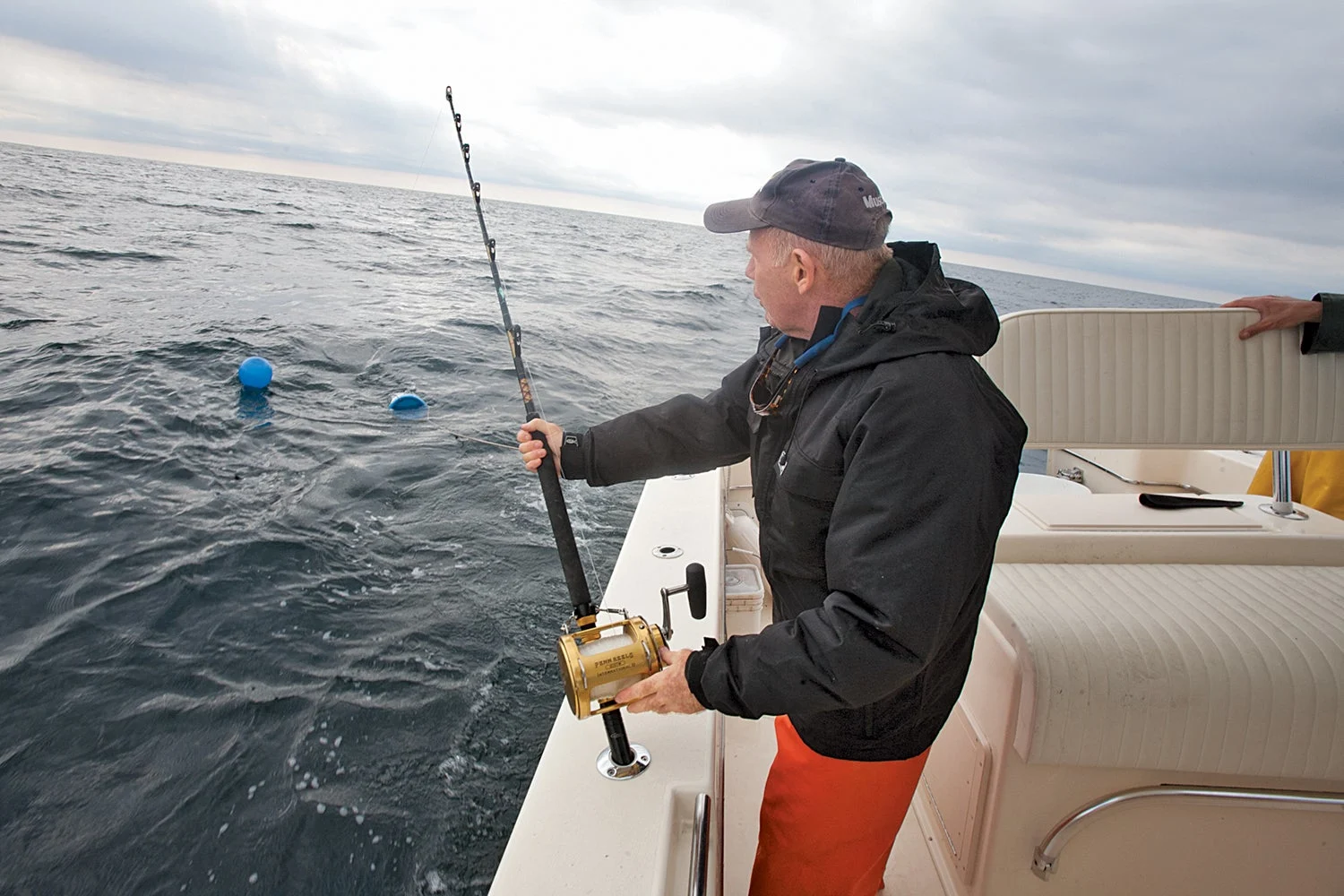
Brown lets out the baits—a whole bluefish, a blue fillet, and a bunker—downtide. Tyler Hicks
This was Lesson One: the drag bucket.
If there were sharks in the area, they would be moving toward those draggers. Brown had a plan to deceive them. As the bucket trailed the boat, the warm seawater was thawing the frozen chum, which leaked through the holes. We were making our own long slick, a drapery of blood and fish oil that grew as we moved. I steered the boat perpendicular to the draggers’ by-catch slicks, crossed them, and continued on for another third of a mile. Now any shark approaching the draggers from their sterns, and seeking a slick, would encounter ours, which led to our boat. As I cut the engines, Brown was already rigging three rods with Penn 80s loaded with 100-pound-test. For terminal tackle, Perra had attached a piece of 600-pound mono to an 8/0 600-pound swivel to 460-pound 7×7 stainless-steel cable to another swivel followed by 400-pound steel wire to a 14/0 hook attached with a haywire twist. Brown rigged each rod with its bait. The first held a whole bluefish, the second a bluefish fillet, and the last a whole bunker. Each was suspended beneath a party balloon, which he let out downtide. Each reel was in free spool, with only its clicker on.
A seagull landed beside the boat and paddled alongside. Optimism? Maybe. But Brown was of a practical mind. “If we don’t catch something within an hour,” he said, “let’s go.”
Shark On
It didn’t take long. After a few minutes one of the reels began to squeal. Something had taken the whole bluefish and was running off. Whatever it was, it was strong and fast. It had picked up an 8-pound fish and was propelling itself away at a clip. Brown gingerly lifted the rod from its holder as more line peeled away.
“Who wants this fish?” he asked.
Frye took the rod, keeping its tip low and pointed toward the fish. Three species were the most likely predators here: blue sharks, threshers, and makos. Threshers have small mouths. It’s best to let them carry a large bait for a while, so they have time to take it in. Frye waited. Several seconds passed. The fish stopped. Frye hauled back, hoping to drive the hook home. Nothing was there.
The fish had dropped the bait.
The sky turned A dark gray, leaning toward black. A lower ridge of clouds, white and swirling, formed a leading edge. We were about to get slammed.
Frye reeled in the bluefish and examined it. It had a crescent of small bite marks. “Thresher,” Brown said. “Anything else would have mangled it.”
The fish had slipped off ahead of the hookset, but Brown had made his point. There were several boats around, fishing conventionally. None had any action. Brown had coaxed a fish toward his baits in minutes. Never mind the popular impression that shark fishing is simply letting blood and fish oil call in the beasts. There was something more to this.
A Turn for the Worse
The fishing went quiet after the first strike. After an hour, Brown had us move off toward the temperature break, where we set up again the same way—absent the draggers. Perra and Frye took turns ladling chum over the side and cutting butterfish into nickel-size chunks and flicking them over. As we drifted on the tide, the day took its own direction. To the west, low on the water, the sky turned a dark gray, leaning toward black. A lower ridge of clouds, white and swirling, formed a leading edge. The sea was calm. But we knew what this meant. “Let’s get those lines in fast,” Brown said. We were about to get slammed.
To the north, a larger vessel was visible, perhaps a 35-footer with a low tuna tower. It was powering up, too, and about to dash. We knew our boat would be faster before the seas slowed us, and that we could tuck in behind her and be available to help each other. The bigger vessel could also break the waves, making it easier for our smaller craft to keep headway in what would soon be steep, snotty seas. “Follow that boat,” Brown said.
But it was impossible. As the leading edge of clouds overtook us, the wind switched on at a gale. Sheets of rain came a minute or two behind. Sea smoke—formed when cold air drifts across warm water—swirled. Water lashed by sideways and pelting. Visibility shrank to perhaps 200 feet. And the seas climbed. The conditions rendered the radar useless. Even when we adjusted the clutter settings, fighting to steer and use the electronics at once, it read the air around us as a solid band of water. Judging from the picture, we might as well have been in a hole, and there was no chance of finding the boat ahead and vectoring toward it. The boat had vanished. We were alone. My mind flashed through the inventory as the bow slammed into a building wave. Sixty-five miles out: life jackets, flares, water, first-aid kit, emergency beacon, and floating radio. Solid crew. Luck. Had we packed luck?
Brown’s bright eyes sparkled, mixing wonder and concern.
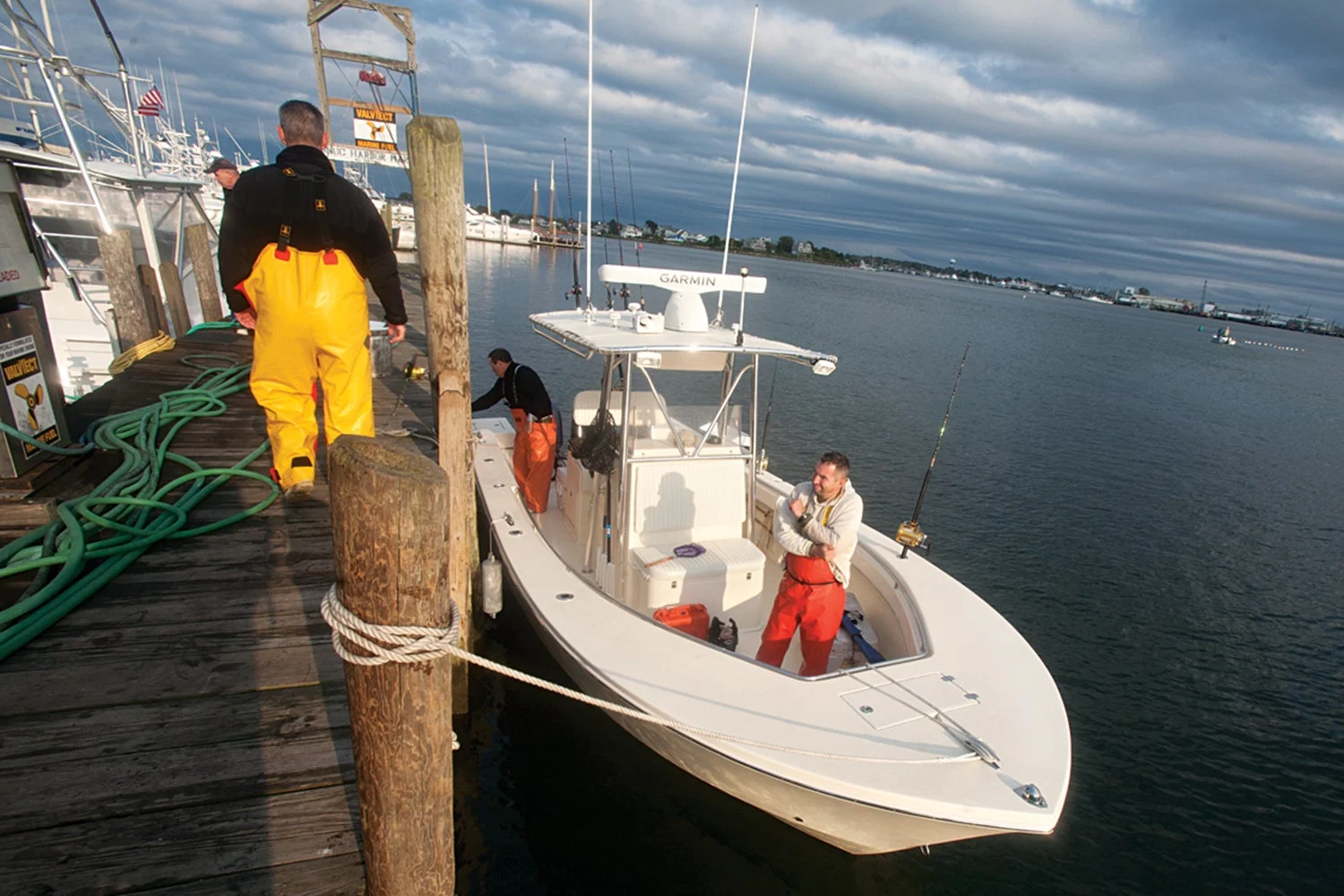
The crew returns to the dock. Tyler Hicks
For almost two hours we pushed north, rising, falling, moving slow. The spray lashed us. Hicks, Perra, and Frye huddled on the deck, and Brown and I stood at the helm. The storm moved east as we traveled, and slowly we came out of its grip and into the light. The wind died as we pulled away. Fortunately there was no lightning. We emerged to rough seas but manageable winds, and as it grew safer we accelerated. Three hours later we could see the outline of Block Island, and passed it by our right bow. We were drenched, stiff, and cold. But safe. Time for the dock. We came to an idle, and dumped over the extra chum, food for the crabs and gulls. With the engines quiet, we huddled and checked on one another, shaking heads at a trip stopped in a moment by a backdoor squall.
“Sea smoke?” Brown said. “You don’t get that very often.”
Lesson Two was intact: A small boat taking trips like these should have a weather radar service. That storm had not been in the forecast and there had been no warning of it over the radio as we fished. (The boat now has the service, which displays moving storms on the screen.)
Sharkers in Training
Lessons logged away, Hicks and I soon headed back to Afghanistan for work, leaving the rest of the fall fishing to Brown, Perra, and Frye. We all resumed our normal lives. And yet one trip can inform others in strange ways, because if accounts of large fish slipping the hook serve any purposes, then one of them is this: to inspire fishermen to return to the water, filled with ideas and hopes.
Jack and Mick had sat at our kitchen table the night before we departed offshore, and had listened to Capt. Brown talk about the sharks a few hours’ steam beyond the break walls. That was hours after they had chased bluefish with hopes of filling the bait cooler. And they had seen us return the next evening: soaked, cold, tired, walking slowly but talking fast. They were younger that day—aged only 8 and 6—too young for a journey toward the canyons in a 26-foot open boat, too young to put the brakes to fish that could weigh several hundred pounds. Their time offshore was yet to come, and in any event there would be no more chances to chase a mako or thresher that fall. But since that evening the boys have been preparing. When work allows me to be home in summer, and the blues turn up in schools and start hammering plugs off Point Judith, no fish can come aboard without the command, unprompted and eager, from one of the crew: “Bleed it, Dad.” And that is just a part of it. Each trip to the rips to haul bass, each drift over the deep rocks inside the Hooter Buoy, each night jigging squid at anchor on Nebraska Shoal, and each of the journeys back to port, with me at the helm and Jack and Mick standing in the bow on lookout as we thrum slowly through an all but impenetrable fog, each time, in other words, when we fish, they ask: When will you take us for shark?
_This story originally ran in the May 2012 issue. Read more F&S+
stories._

